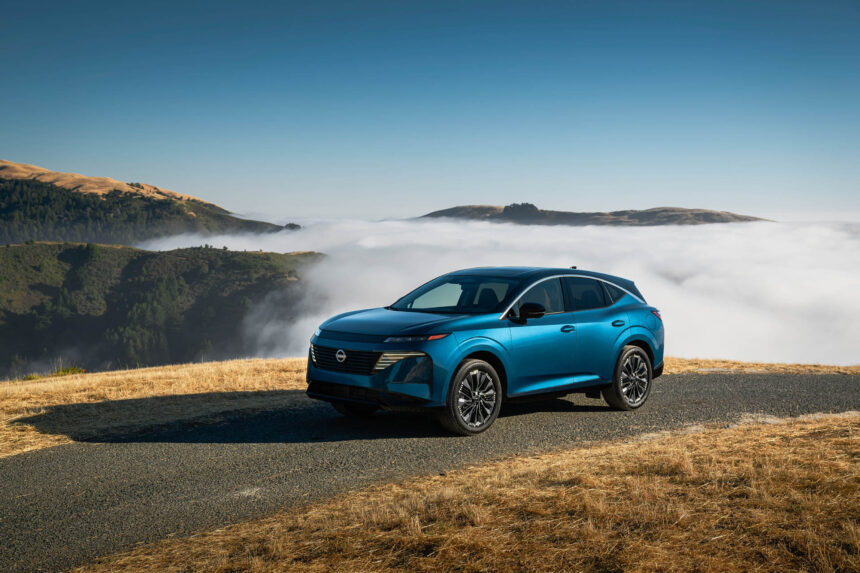The 2025 Nissan Murano is a midsize crossover SUV that offers seating for five passengers and falls into the middle ground of the crossover segment. It competes with other midsizers such as the Hyundai Santa Fe, Jeep Grand Cherokee, and Mazda CX-70.
The redesigned 2025 Nissan Murano features a new look and a new powertrain, while maintaining a similar footprint to its predecessor. With added technology and more standard safety and convenience features, it is expected to improve upon the previous model’s TCC Rating of 6.2 out of 10. However, Nissan has lagged behind competitors in offering hybrid, plug-in hybrid, or electric vehicle options.
Several updates have been made to the fourth-generation Murano, including a slight increase in width and a higher ground clearance of 8.3 inches, giving it a more SUV-like appearance. The exterior design incorporates modern elements such as a floating roof, a V-shaped grille, larger wheels, and a sleek profile with a coupe-like roofline.
Under the hood, the 2025 Murano is powered by a 2.0-liter turbo-4 engine that produces 241 horsepower and 260 lb-ft of torque. This engine is paired with a 9-speed automatic transmission, replacing the previous V-6 engine and CVT. Despite the new powertrain, fuel economy remains the same at 23 mpg combined for both front-wheel drive and all-wheel drive models.
Inside, the Murano boasts premium features such as active noise cancellation, dual 12.3-inch digital displays, ambient lighting, and a clean, uncluttered interior design. The cabin is equipped with soft-touch materials, comfortable seating, and ample storage space. Driver-assist technology is also standard, including automatic emergency braking, blind-spot monitors, lane-keeping assist, and adaptive cruise control.
The 2025 Nissan Murano is expected to be priced above $40,000 but below $50,000, with three trim levels available: SV, SL, and Platinum. Standard features include wireless Apple CarPlay and Android Auto, a wireless smartphone charger, power tailgate, synthetic leather upholstery, and heated front seats. Optional upgrades include a Bose sound system, power-folding mirrors, massaging front seats, Google built-in, and a surround-view camera system.
Production of the 2025 Nissan Murano takes place in Canton, Mississippi. Overall, the new Murano offers a blend of style, technology, and comfort in the competitive midsize crossover SUV segment. The world is constantly changing and evolving, with new technologies, trends, and innovations emerging every day. One of the most exciting areas of growth in recent years has been in the field of artificial intelligence (AI). From self-driving cars to virtual personal assistants, AI is revolutionizing the way we live and work.
One of the key drivers of this AI revolution is the development of deep learning algorithms. Deep learning is a subset of machine learning that uses artificial neural networks to model and understand complex patterns in data. These neural networks are inspired by the structure of the human brain, with layers of interconnected nodes that process information and make decisions.
One of the key benefits of deep learning is its ability to learn from large amounts of data without being explicitly programmed. This means that AI systems can improve and adapt over time, becoming more accurate and efficient at tasks such as image recognition, speech synthesis, and natural language processing.
One of the most well-known applications of deep learning is in the field of computer vision. By training neural networks on vast datasets of images, researchers have been able to develop AI systems that can accurately identify and classify objects in photos and videos. This has a wide range of practical applications, from facial recognition technology to autonomous drones.
Another exciting area of growth for deep learning is in the field of natural language processing (NLP). By training neural networks on large corpora of text data, researchers have been able to develop AI systems that can understand and generate human language. This has led to the development of virtual personal assistants like Siri and Alexa, as well as powerful translation tools that can break down language barriers.
Looking ahead, the future of deep learning looks bright. Researchers are constantly pushing the boundaries of what is possible with AI, developing new algorithms and techniques to improve the performance and efficiency of neural networks. As the technology continues to advance, we can expect to see even more innovative applications of deep learning in fields such as healthcare, finance, and education.
In conclusion, deep learning is a powerful tool that is transforming the way we interact with technology. By harnessing the potential of artificial neural networks, researchers are able to develop AI systems that can learn, adapt, and improve over time. As we continue to explore the possibilities of deep learning, we can look forward to a future where AI plays an even greater role in shaping our world.







